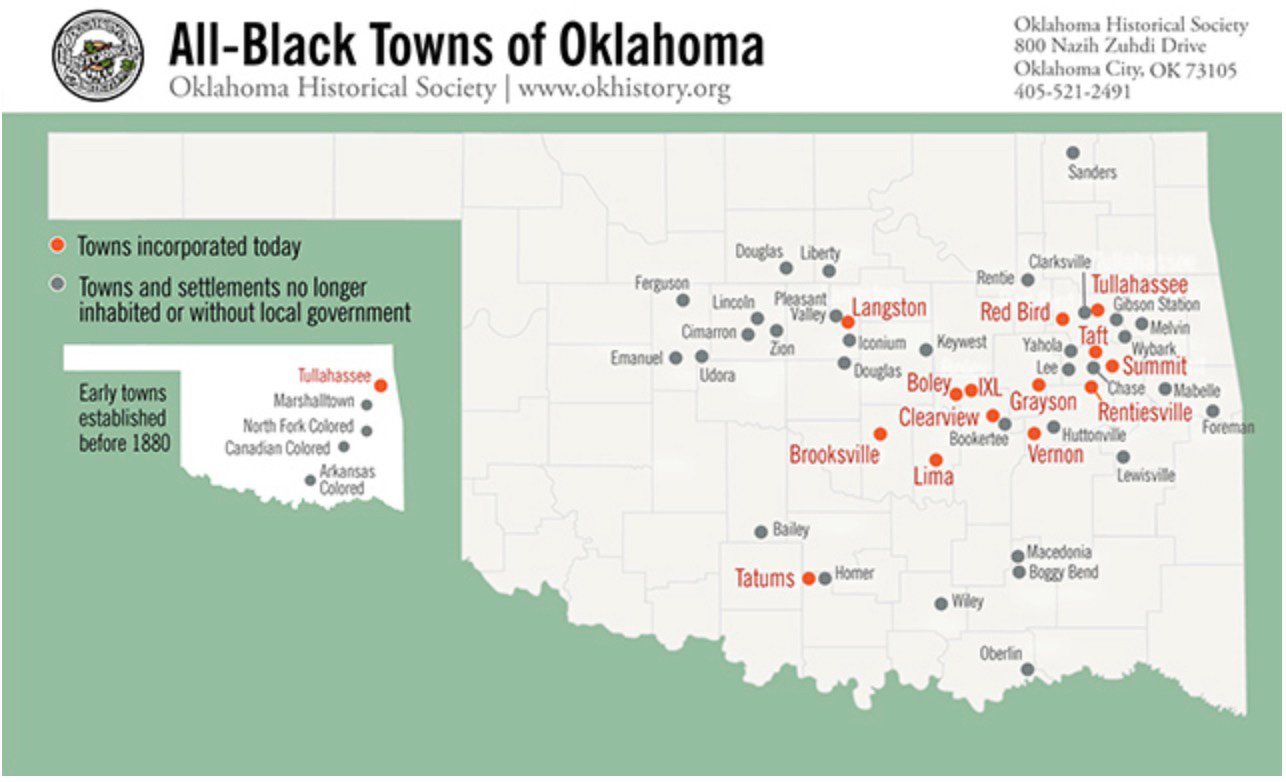Let’s get started with a brief history: All-Black Towns of Oklahoma
The All-Black towns of Oklahoma represent a unique chapter in American history. Nowhere else, neither in the Deep South nor in the Far West, did so many African American men and women come together to create, occupy, and govern their own communities. From 1865 to 1920 African Americans created more than fifty identifiable towns and settlements, some of short duration and some still existing at the beginning of the twenty-first century.
Today, only thirteen all-black towns still exist, but their importance in Oklahoma's history remain. Towns that still survive are Boley, Brooksville, Clearview, Grayson, Langston, Lima, Red Bird, Rentiesville, Summit, Taft, Tatums, Tullahassee, and Vernon. The largest and most renowned of these was Boley.
All-Black towns grew in Indian Territory after the Civil War when the former slaves of the Five Tribes settled together for mutual protection and economic security. When the United States government forced American Indians to accept individual land allotments, most Indian "freedmen" chose land next to other African Americans. They created cohesive, prosperous farming communities that could support businesses, schools, and churches, eventually forming towns. Entrepreneurs in these communities started every imaginable kind of business, including newspapers, and advertised throughout the South for settlers. Many African Americans migrated to Oklahoma, considering it a kind of "promise land."
The History of Oklahoma Black Townships
Black Townships in Oklahoma have a long and complex history that can be traced back to the period of Reconstruction following the Civil War. After the Civil War, many former slaves and their descendants migrated to Oklahoma in search of land and economic opportunities. However, they were often discriminated against and denied access to land and resources by the white settlers who dominated the state. In response, many Black Oklahomans formed their own communities and settlements, known as Black Townships.
The Black Townships in Oklahoma were established as self-sustaining communities where Black residents could own land and businesses and have a degree of autonomy from white-dominated society. These townships were often formed in rural areas where land was cheaper and more accessible to Black settlers. Some of the most well-known Black Townships in Oklahoma include Boley, Clearview, Taft, and Langston.
In the early 20th century, the Black Townships in Oklahoma became thriving centers of Black culture and commerce. Black-owned businesses, schools, and churches flourished, and the townships were seen as models of Black self-determination and resilience. However, in the 1920s and 1930s, many of these townships were devastated by the Great Depression and a series of droughts and natural disasters. Many Black residents were forced to leave the townships in search of work and economic opportunities elsewhere.
Today, the legacy of Black Townships in Oklahoma can still be seen in the vibrant Black communities that continue to thrive throughout the state. These communities have played an important role in shaping the cultural and economic landscape of Oklahoma and remain an important symbol of Black resilience and self-determination in the face of adversity
Who Established Black Townships in Oklahoma
The Black Townships in Oklahoma were established by Black settlers, many of whom were former slaves or their descendants, who migrated to the state in search of land and economic opportunities following the Civil War. These settlers faced significant discrimination and exclusion from white-dominated society in Oklahoma, which led many of them to form their own self-sustaining communities where they could own land and businesses and have a degree of autonomy.
While Black settlers established these townships, they often received support from organizations such as the Freedmen's Bureau, which was established by the federal government to help former slaves and their descendants transition to freedom and citizenship. The Freedmen's Bureau provided education, housing, and other forms of assistance to Black settlers, which helped them establish these self-sustaining communities.
One of the most well-known Black Townships in Oklahoma, Boley, was established by a group of Black settlers in 1903. The settlers, led by a man named Edward P. McCabe, purchased land from a white farmer and began building homes and businesses. Boley quickly became a thriving center of Black commerce and culture, with Black-owned businesses, schools, and churches. Boley served as a model for other Black Townships in Oklahoma and beyond.
Overall, the Black Townships in Oklahoma were established by Black settlers who sought to create their own self-sustaining communities in the face of discrimination and exclusion. These townships served as important centers of Black culture and commerce and remain an important symbol of Black resilience and self-determination in Oklahoma's history.
Revenue Sources in the Black Townships of Oklahoma
The specific sources of revenue in the Black Townships of Oklahoma varied by individual town and changed over time. However, there were some common sources of revenue that many Black Townships relied on:
Agriculture: Many Black Townships were located in rural areas with fertile land that was suitable for farming. Black residents in these towns often engaged in agriculture, growing crops such as cotton, wheat, and corn. Agriculture was a significant source of revenue for towns such as Boley and Clearview.
Business: Black residents in the Black Townships of Oklahoma were often entrepreneurs who owned and operated businesses. These businesses included grocery stores, gas stations, restaurants, and other small businesses that catered to the needs of the Black community. Black-owned businesses were an important source of revenue for towns such as Langston and Taft.
Oil and Gas: In the early 20th century, Oklahoma was a major producer of oil and gas, and many Black Townships benefited from this industry. Some towns, such as Grayson, were established specifically to serve the needs of workers in the oil and gas industry.
Education: Some Black Townships in Oklahoma were home to historically Black colleges and universities, which were an important source of revenue for the towns. For example, Langston University, located in the town of Langston, was a significant employer in the town and contributed to its economic growth.
Overall, the sources of revenue in the Black Townships of Oklahoma were diverse and often intertwined with the unique histories and circumstances of each individual town.
Native American Tribes Influences With Black Townships of Oklahoma
The relationship between Native American tribes and Black Townships in Oklahoma has been complex and varied throughout history.
In the late 19th and early 20th centuries, when many Black Townships were first established, they often existed in close proximity to Native American reservations. In some cases, Black settlers and Native Americans formed alliances and cooperated in their efforts to secure land and resources from white-dominated society. For example, in the early 1900s, the town of Taft was established near the Creek Nation reservation, and Black and Creek residents worked together to establish schools, churches, and businesses.
However, the relationship between Native American tribes and Black Townships was not always harmonious. In some cases, Native American tribes actively opposed the establishment of Black Townships on their land, viewing them as a threat to their sovereignty and economic interests. For example, in the early 20th century, the Seminole Nation of Oklahoma passed laws prohibiting the sale or lease of tribal land to Black settlers. This led to tensions between Black settlers and the Seminole Nation and made it more difficult for Black Townships to establish themselves in the area.
Another way in which Native American tribes impacted Black Townships in Oklahoma was through their participation in the oil and gas industry. As Oklahoma became a major producer of oil and gas in the early 20th century, Native American tribes were often granted mineral rights on their land. This led to significant economic growth for some tribes, but it also created tensions between Native Americans and Black residents who were excluded from these economic opportunities.
Overall, the relationship between Native American tribes and Black Townships in Oklahoma has been shaped by a complex mix of cooperation, competition, and conflict. While there have been moments of solidarity and mutual support, there have also been significant challenges and tensions that have impacted the development and success of Black Townships in the state.
Challenges to Growth in the Black Townships in Oklahoma
The Black Townships in Oklahoma have faced a variety of challenges to growth and development over the course of their history. Some of these challenges include:
Discrimination and Segregation: Black residents in Oklahoma faced significant discrimination and segregation from white-dominated society, which limited their access to resources and opportunities. The passage of many Jim Crow laws by the Oklahoma Legislature immediately after statehood caused some African Americans to become disillusioned with the young state. A large group of Oklahomans joined the ill-fated Chief Sam expedition to Africa. A number of other African Americans migrated to colonies in Mexico. This made it more difficult for Black Townships to grow and develop, as they often lacked access to capital, markets, and infrastructure.
Economic Instability: The Black Townships in Oklahoma were often located in rural areas with limited economic opportunities. Many Black residents in these towns engaged in agriculture or small-scale entrepreneurship to make a living, but these industries were subject to market fluctuations and other economic pressures that could make it difficult to sustain growth.
Lack of Infrastructure: Many Black Townships in Oklahoma lacked basic infrastructure such as paved roads, running water, and electricity. This made it more difficult for businesses and residents to thrive, and also made it more difficult for the towns to attract outside investment and support.
Limited Access to Education: Black Townships in Oklahoma often lacked access to high-quality education, which limited the opportunities available to residents. This made it more difficult for the towns to attract and retain skilled workers and entrepreneurs, and also limited the potential for economic growth and development.
Environmental Challenges: Some Black Townships in Oklahoma faced environmental challenges that impacted their growth and development. For example, the town of Boley was located in an area with poor soil quality, which made it more difficult for residents to engage in agriculture and limited their economic opportunities.
Overall, the challenges facing the Black Townships in Oklahoma have been numerous and complex. Despite these challenges, many Black Townships in the state have persisted and continue to serve as important centers of Black culture and community today.
Information Sources/Reference
Sources include Oklahoma Historical Society, University of Tulsa, and other internet searches regarding the history of the Black Townships of Oklahoma

